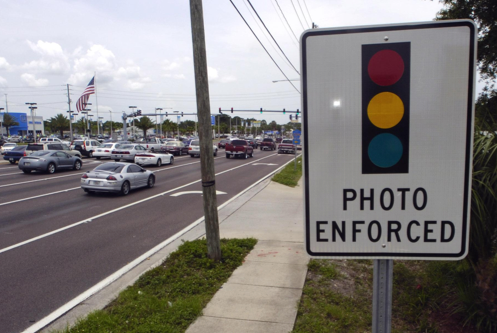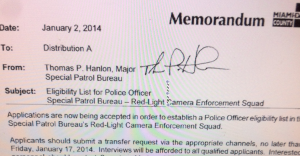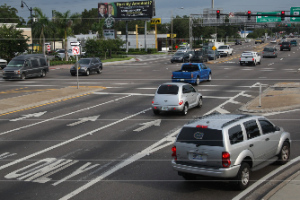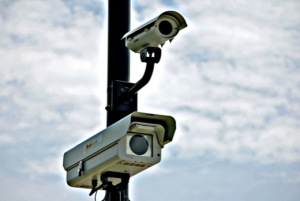Smile as you go under that yellow traffic light: There are many more red light cameras coming soon to 150 intersections near you.
 Yes, it appears that red light cameras — which have been limited to municipal streets — are headed to intersections in unincorporated Miami-Dade, after all. Or finally.
Yes, it appears that red light cameras — which have been limited to municipal streets — are headed to intersections in unincorporated Miami-Dade, after all. Or finally.
This has been a long time coming, since county commissioners first approved a motion in 2005, sponsored at that time by then-Chairman Joe Martinez, to explore the program. Martinez has since changed his mind and on his last meeting Nov. 8, 2012, he tried to get rid of it but the motion failed.
A request for proposals finally went out last month, three days after the commission approved an ordinance that established a hearing process for red light camera violations under new state laws that passed last year. The deadline is Jan. 24, when the proposals for the multimillion dollar contract will be opened at 2 p.m.
We can expect bids from the same two firms as always — American Traffic Solutions and Affiliated Computer Systems, heretofore known as ATS and ACS — which are the only two companies that do business in Miami-Dade, as well as other companies that work in other parts of the state and the nation.
According to one source, five companies showed up to the pre-bid conference with county procurement people: ATS and ACS, as well as Redflex, Sensys and Gatao.
And if history is any indicator, we can also expect much meddling from political insiders and a bid protest at the end of the process. The contracts that have been won at cities have been hard fought. And this is for 150 intersections — possibly expanded to 200 — in unincorporated Miami-Dade, where there are hundreds of “dangerous” corners to choose from. The cameras will be installed in phases, 50 intersections at a time (multiple cameras per intersection), and the county reserves the right to remove any at its discretion, according to the RFP.
It is a very coveted chunk of change.
“This will be huge,” said one industry insider. “This will be something everybody has been trying to get for a long time.”
And Ladra is willing to bet that this RFP is fast tracked. It may go back to commissioners as early as the first next meeting after Jan. 24.
That’s why the Miami-Dade Police Department is already recruiting officers for a special “red light camera enforcement squad” who will “review and certify images captured by the automated red light camera enforcement system, ap prove or disapprove violations, [and] prepare monthly reports.” That’s the job description according to a memo sent Jan. 2 by Special Patrol Bureau Major Thomas Hanlon to officers who may want to apply for an “eligibility list” (in the photo above).
prove or disapprove violations, [and] prepare monthly reports.” That’s the job description according to a memo sent Jan. 2 by Special Patrol Bureau Major Thomas Hanlon to officers who may want to apply for an “eligibility list” (in the photo above).
Deadline for applicants is Jan. 17, one week before the deadline for the bids.
So what changed? What brought on this spate of activity on the red light camera front after months of dormancy?
Well, for one thing, the county may have been waiting for changes in the law. Last year, the legislature passed a bill that clarified an issue with right hand turns at red lights — one of the major causes for appeals — and also changed the rules to make it easier for violators to plea their case in a hearing. Martinez was also losing faith already and, as chairman then, he blocked any further action on it.
Another thing: Miami-Dade Mayor Carlos Gimenez‘s son no longer works as a lobbyist for ATS, which is the main game in town with all 20 or so of the city contracts in the county, except for half of Miami Beach. The mayor — who got a lot of grief about his “lobbyist son” — has repeatedly said he recused himself from any vote or discussion related to red light cameras when he was a commissioner, even though his spittin’ image really only lobbied for ATS at the cities. But records show he also sponsored three pro-red light camera resolutions in 2007, 2008 and 2009. But in 2011 and 2012 he was in the midst of a mayoral election and then re-election campaign. Not a good time to start putting red light cameras at 150 of the intersections voters use most.
It may also be politically safer to go there now, since CJ Gimenez left Becker Poliakoff about a year ago and now works for Freddy Balsera — who, as far as we know, has nothing to do with the red light camera cottage industry. Yet.
Who does? Sen. Miguel Diaz de la Portilla and lobbyist Armando Gutierrez still represent ATS at the county level. At one time, the Arizona-based company had 24 lobbyists in Tallahassee and working on cities throughout the state, including Ron Book and former Miami-Dade Commissioner Larry Hawkins, who was embroiled in an office sexual harassment scandal and subsequently taken out of office by former Commissioner Katy Sorenson. Also involved is Hector Ortiz, a contractor and serial campaign contributor who was once banned from getting county contracts because of suspected graft but is now the sole installer for ATS cameras. Lob byists Brian May and Steve Marin (who is also a campaign consultant for candidates) represent the No. 2 firm in town, ACS, a division of Xerox that has the cameras in half of Miami Beach.
byists Brian May and Steve Marin (who is also a campaign consultant for candidates) represent the No. 2 firm in town, ACS, a division of Xerox that has the cameras in half of Miami Beach.
Make no mistake about it: Red light cameras are big business.
The Florida Department of Revenue reported that red light camera citations generated more than $62 million in revenue for the state between June of 2012 and last June. The state gets $83 of the $158 fine. Of that, $70 goes to the general fund while trauma centers like Jackson Memorial Hospital get $10, and the Miami Project to Cure Paralysis gets $3. The remaining $75 goes to the municipality, which has to pay the vendor — either ATS or ACS around here — for the costs of installing the equipment, which can cost between $200,000 and $500,000 per intersection. You do the math.
Many city officials have recently admitted that the red light cameras are not the financial windfall they were expecting — for them. Because so many citations are challenged and dismissed — some statistics quoted to me are up to half — and appeals take a long time, cities might not be generating the kind of kaching they projected. Additionally, if the red light camera programs have the effect that proponents (read: industry insiders) desire — that is, the modified behavior of drivers who slow down at yellows rather than speed up — then there are going to be fewer violations as the trend ages. Proponents do say that there is a steady number that can be projected.
Those figures vary and the jury is still out. The formula becomes even more complicated when municipal governments take on costs for establishing a hearing process, as the county did Dec. 3. Even Gimenez’s office admitted that in the memo to commissioners for the meeting.
“The cost of providing local hearings cannot be fully determined at this time,” Gimenez’s memo states. “Should the cost exceed the $150 charge that this ordinance provides for, the cost would either have to be absorbed in the budget by reducing other services or an amendment to this provision could be approved to fully recover to the county’s cost, to the extent that permitted by the state statute.”
Some critics say that cities add more cameras or shorten the length of time between the yellow and the red light to make up for the shortfall of revenues projected in the budget. Hey, think about it: About half the violators do not challenge the citation. The fee for which, by the way, will likely go up. Florida law currently allows municipalities to charge up to $250 for red light camera violations. That is likely to increase, too, with legislative approval.
 But one thing is clear: ATS and ACS will certainly make their profit margin. And the lobbyists are getting paid their retainers.
But one thing is clear: ATS and ACS will certainly make their profit margin. And the lobbyists are getting paid their retainers.
And they talk a good game.
ATS touts statistics that indicate a 42% drop in rear-end crashes and a 52% drop in all collissions at city of Miami intersections with red light cameras per year in the three years since the program started. One intersection in Aventura, at William Lehman and West Country Club, there has been an 80% decrease in accidents, according to the company’s own numbers.
Drivers have always been against red light cameras, mostly because we don’t trust computerized clickers to get it right all the time and because we love that old tradition of a police officer having to actually witness a crime before someone could be cited or arrested (which comes next, people, watch). And, yes, there are those of us don’t like to slow down when the light turns yellow.
But the promised profits to government are the reason some political people — who say there are alternatives to making intersections safer — are turning against this trend. They say that the cameras were sold to us as an enhanced safety measure but are really a circumvent way to create a new revenue stream to shore up struggling governments budget vís-a-vís a new cottage industry that blossomed out of nowhere and also happens to financially benefit a few of the of the connected friends and contributors of politicians who have the power to install them.
Miami-Dade Commissioner Juan Zapata has voted against the red light cameras consistently and was against them when he was a state rep. He doesn’t buy the sales pitch.
“This is not safety policy. This does not make us safer. This is all a financial scheme for interested parties,” Zapata said, adding that there are more effective alternatives that do not balance the budget on the driver’s back.
Miami Commissioner Francis Suarez is one of the most vocal opponents of what he calls a “traffic tax” and has done research — he calls it an “investigation,” which is maybe what there should be, officially — which indicates they do not save lives as much as they brag to. It was a great campaign issue that would have helped him if he had not abandoned the mayoral bid because of several campaign mistakes that were seemingly pounced on. And, no, it has nothing to do with the two citations he received and for which he got far more grief than he deserved.
By the way, in the interest of full disclosure, Ladra has gotten two red light camera tickets, too, since this malaise infected our roadways. And I do not run red lights. I’m not saying this because I’m any kind of saint behind the wheel (those who have been in the car with me know what I am talking about). I say this because I never have to run red lights. I’d rather break the speed limit and switch lanes often, weaving and bobbing, to avoid traffic lights in the first place. So, you see? The program is flawed.
But Ladra didn’t like the idea before the surprise mailed citation arrived, anyway. And Suarez probably didn’t either.
The commissioner says that the majority of the Miami intersections where cameras are placed within the city are intersections that have had zero or maybe one accident in the last two years. Ladra suspects that happened after more cameras were hastily added to more intersections when the city failed to reach its projected $8 million in revenue from red light violations. What did they get? $2 million. That created a $6 million shortfall in the city budget, which is more than one percent. But instead of discontinuing the program, the city just added more cameras. And this is not revenue motivated? Really?
Suarez complains that most of those new cameras posted at intersections with zero accident history are in the low income, urban areas of the city. “The foothills of Little Havana,” a mutual friend of his and Ladra’s calls them.
“We have become the camera capital of the State of Florida. We have more cameras than the next six cities in the state combined,” Suarez said in one of his campaign videos before he abandoned his mayoral bid in the wake of several missteps (this was not one of them), and a dding that Miami has a quarter of all the red light cameras in Florida.
dding that Miami has a quarter of all the red light cameras in Florida.
“Our citizens feel that the red light camera program in the city of Miami is abusive. They feel that it’s an involuntary traffic tax,” he said, adding that there are other alternatives such as “yellow light counters” and timing adjustments.
“All of these techniques have shown dramatic reduction in traffic accidents without imposing a $10 million fee to the residents,” Suarez said. “Our residents feel that this red light camera program is just another example of government trying to find a way to reach into their pocket.”
Damn, he would have made a fine mayor.
His dad, Miami-Dade Commissioner Xavier “Mayor Sir” Suarez would have voted against the ordinance sponsored last month by Commissioner Sally Heyman, but he was absent when the item came up. As was Commissioners Jose “Pepe” Diaz and Bruno Barreiro. The two dissenting votes were from Commissioners Zapata and Esteban “Stevie El Bobo” Bovo, who represents Hialeah, a city where the mayor rescinded the red light cameras. I’m no fan of Hialeah Mayor Carlos “Castro” Hernandez, but even a twisted, politically abusive, tyrannical dictator must be commended when he gets something right.
Suarez Sr. asked Commission Auditor Charles Anderson last summer if there was a way that the county could do some sort of cost benefit analysis. He, too, is concerned that the pretty painted picture is pure P.R. “I don’t see any indication that the county is reimbursed with any proportionality to the cost incurred,” Suarez Senior wrote in the memo to Anderson.
“I have been against this since Day One,” Suarez told Ladra. “You cannot imagine the number of constituents who have complained about this.”
No, Commissioner, you and your colleagues cannot imagine the number of constituents who are going to complain when they get wind of the 150 more red light camera intersections in the works.
Suarez became more interested in the process after his wife received what he said were two bogus violations (See? Ladra is not alone). He said he could not believe how “cumbersome” it was for the alleged violators who are punished simply for appealing his citation. Drivers who lose their case have to pay an additional $119 more.
He provided me with statistics provided to him by Chief Judge Bertila Soto of the 11th Circuit Court that show that a whopping 33% of the cases appealed — which are about half the violations issued — are dismissed and that most of those are because of right turns on reds, which a camera attached to a computer cannot discern. That may have been addressed with legislation to clarify a red light turn with a full stop first and one without, but we will wait and see.
Soto says that one courtroom is dedicated to red light camera violations, with an estimate of about 350 defendants daily, or 1,750 a week, who go before a civil hearing officer. About 50 people go before a judge every week, she added.
Wait for that to more than double by the time the county’s program has been in effect for a few months.
In Miami-Dade alone, the number of red light camera violations has skyrocketed from 9,996 in 2010 — the first year a state law legalized them — to 116,395 in 2011, to 131,961 in 2012 and an estimated 155,664 last year. That is almost 15 times as many as four years ago.
Ladra bets there will be more than 200,000 once the Miami-Dade program is in effect.
And this is probably multiplied into the millions if you look statewide.
In Tallahassee, where red light camera bans and tweaks are proposed every year, there are new bills to put the brakes on this runaway truck, shall we say, making their way to the Senate and the House — sponsored by Sen. Jeff Brandes (R-St. Petersburg) and Rep. Frank Artiles (R-Country Walk). respectively.
“This program was originally sold as being about safety. I have come to believe that it’s now about revenue,” Brandes was quoted as saying.
Well, maybe in Miami-Dade, people will support it — so long as the revenue goes to keep libraries open or something rather than disappear into a polar vortex of its own.
